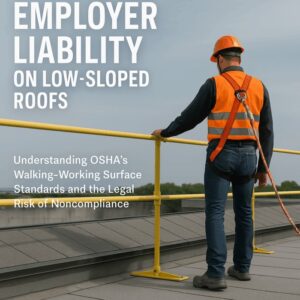Understanding OSHA’s Walking-Working Surface Standards and the Legal Risk of Noncompliance

In construction and facility management, roofs are often treated as extensions of workspace—places where maintenance, inspection, and repairs occur routinely.
But despite their common use, rooftops present serious safety hazards. Especially on low-sloped roofs, which may not appear dangerous at a glance, the risk of falls and the legal exposure that follows are both significant.
When employers fail to comply with OSHA’s fall protection standards for low-sloped roofs, they risk far more than just a citation. The consequences can include serious injuries, lawsuits, and long-term liability that can affect both finances and reputation.
OSHA’s Walking-Working Surface Rule
To address the dangers associated with elevated surfaces, OSHA’s Walking-Working Surfaces standard outlines the minimum requirements for protecting employees from falls. This includes platforms, ladders, scaffolds, and roofs.
A key component of this regulation is the fall protection requirement for low-slope ratio roofs, which are defined as having a slope of less than four inches of vertical rise for every twelve inches of horizontal run.
Many employers mistakenly believe that the flatter the roof, the lower the risk. But OSHA sees it differently, and for good reason. Workers can easily trip, slip, or misjudge distance, especially when distracted or working near the edge. Fall accidents on these surfaces are not only common but often catastrophic.
Legal Risks for Employers Who Fail to Comply
When employers fail to install or enforce proper fall protection systems on low-sloped roofs, they open themselves up to multiple legal vulnerabilities.
OSHA Fines and Inspections
If an accident occurs and OSHA inspects the site, noncompliance can result in citations and fines. These fines can escalate quickly if the violation is found to be willful or repeated. A single infraction can result in penalties upward of $15,000, while willful violations that result in fatalities may reach into six figures.
OSHA citations can also act as key evidence in civil litigation, helping to establish that the employer failed to meet their legal duty of care.
Civil Lawsuits and Wrongful Death Claims
In cases of serious injury or death, injured workers or their families may pursue civil claims against the employer. While workers’ compensation laws generally protect employers from lawsuits, exceptions are made when gross negligence is involved. If a company fails to provide required fall protection in an area governed by clear OSHA rules, the case may cross the line into actionable negligence.
In addition, contractors or property owners may face third-party liability claims if the injured worker was employed by a subcontractor who failed to meet safety standards.
Reputational and Operational Fallout
Beyond the immediate legal consequences, OSHA violations can trigger a loss of future contracts, heightened insurance premiums, and strained workforce morale. In high-risk industries, a reputation for unsafe practices is difficult to overcome.
What the Standard Requires
For work performed on low-sloped roofs, OSHA requires fall protection when employees are working six feet or more above a lower level. Employers have several options depending on the nature of the work and the proximity to the roof’s edge. These include:
- Guardrail systems
- Safety net systems
- Personal fall arrest systems
- Designated areas with warning lines and safety monitoring
The specific measures depend on where the worker is located and how far from the edge the task is performed. For example, work done more than 15 feet from the edge may allow for alternative controls like designated areas, but any work closer than 6 feet requires active fall protection measures.
It’s important to engage a trained professional when it comes to implementing safety measures in light of OSHA’s rules in these scenarios. This includes equipment standards and enforcement considerations.
Real-World Examples of Liability
A notable example of legal exposure occurred when a worker fell from a low-sloped warehouse roof while performing routine maintenance. OSHA’s investigation revealed that no guardrails, harnesses, or designated safe zones had been used.
Although the employer argued that the roof was considered “safe” due to its minimal incline, the lack of any fall protection violated federal standards. OSHA issued significant fines, and the injured employee filed a civil suit alleging gross negligence. The case ultimately settled for an undisclosed but substantial amount, underscoring the risk of cutting corners with fall protection.
Best Practices for Employers
Avoiding liability begins with understanding and consistently implementing OSHA’s standards. Employers should take the following actions to protect both their workers and their organizations:
Conduct a Hazard Assessment
Evaluate all working surfaces, including rooftops, for potential fall hazards. Identify areas where employees will be within 15 feet of an unprotected edge and implement the appropriate level of fall protection.
Install Permanent Systems Where Feasible
Where regular access is needed, such as rooftops with HVAC units, skylights, or communication equipment, installing permanent guardrails or fall arrest anchors is often the most cost-effective long-term solution.
Train Employees Thoroughly
OSHA requires that all workers exposed to fall hazards receive proper training. This includes recognizing hazards, understanding equipment, and knowing how to use fall protection systems effectively.
Document Safety Procedures
Written safety plans, training logs, inspection records, and hazard assessments help demonstrate your commitment to compliance and can serve as a crucial legal defense if an incident occurs.
Monitor Pollen and Weather Conditions
While fall protection is the priority, environmental factors like pollen, dust, or wet surfaces can also create slipping hazards on flat or low-sloped roofs. Seasonal maintenance, including cleaning and ensuring surfaces are free from debris, reduces risk further.
Summary: Risk Management Starts at the Top
Low-sloped roofs might not look threatening, but they present serious risks, and even greater liability, if employers ignore OSHA’s walking-working surface rules. A fall from even a modest height can result in life-altering injury or death. When that happens, the focus quickly shifts from slope angles to legal exposure.
By implementing proper fall protection systems, especially when following [low slope ratios], and staying proactive with training, assessment, and equipment, employers protect not just their workforce but also their business.
Fall accidents are preventable. The consequences of ignoring prevention are not.

